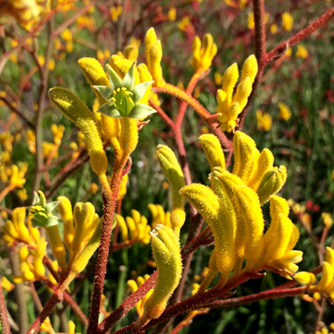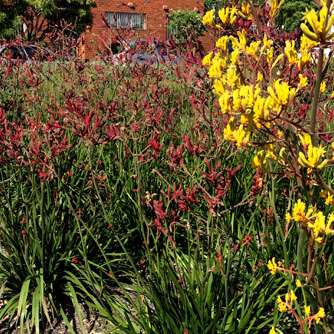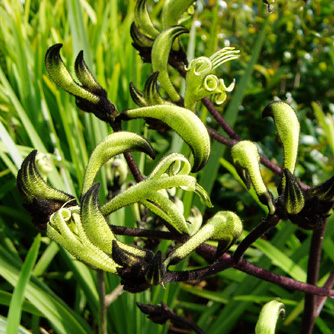Kangaroo Paws
BackKangaroo paws are an iconic Aussie plant loved for their stunning flowers which attract birds and also make great cut flowers.
There are thirteen different species of kangaroo paws (Anigozanthos and Macropidia species) but all are native to southern Western Australia. They range in height (50cm up to 2m), water requirements, soil types and frost tolerance. Choosing the right one for your garden can get quite confusing especially as there are now many different hybrids to choose from as well. To simplify things lets break them down into two groups:
The Tall Guys (growing up to 2m)
These are the easiest of all kangaroo paws and will tolerate a broad range of soils (even damp ones) and climatic conditions (including humid summers). They are perennials which form large clumps over time and produce many flowers in spring and summer.
The Short Guys (under 1m)
Many of the shorter plants are prolific flowerers with some flowering year round in warmer climates. The downside however is that they aren’t as tough as the tall types and require more care. They are shorter lived and more susceptible to fungal diseases. They do very well in pots where it’s easier to give them extra care and where they don’t have to compete with more vigorous plants in a garden bed.

Iconic kangaroo paw flowers
How to Grow Kangaroo Paws
In a nutshell kangaroo paws come from regions which experience cool wet winters and warm dry summers. If you can replicate this then your plants will thrive. If your climate is different to this then try the taller varieties as they are more adaptable. Alternatively grow the smaller types in pots and view them as short-lived perennials. With this in mind you can get happily grow them in cool, temperate and subtropical climates around Australia.
For all types plant in a full sun position with good drainage. Do not plant too deep as this increases the risk of fungal crown rot. Plant at the same level as it was in the pot and water in with OCP eco-seaweed to reduce transplant shock.
For potted plants use a premium quality potting mix. It doesn’t have to be a special native mix as kangaroo paws are not phosphorus sensitive. The sole exception is the black kangaroo paw (Macropidia fuliginosa). In areas with high rainfall add some sand or perlite to ensure better drainage.
Taller types can be given an all over hard prune to remove ratty foliage and finished flower stalks. Large clumps of taller growing types will also benefit from being divided every few years to keep them vigorous. Go easy on the smaller types and only remove finished flower stems and connected foliage. Leave all other foliage untouched as a hard all over prune usually kills these types.
Frost Tolerance of Kangaroo Paws
Kangaroo paws will tolerate light frosts but they can damage new foliage and flower buds. If yours dies right back after a hard frost leave it until spring before doing anything. There’s a good chance its underground rhizome has survived and will reshoot in the warmer weather.

Bed of kangaroo paws in flower
Watering Kangaroo Paws
Once established these plants are relatively drought hardy however to have them looking their best ensure they receive water during their main growing periods (winter and spring). Lack of water during that time will result in fewer flowers and with many buds turning into dry brown clusters. Potted types with extended flowering periods will require watering for longer.
Fertilising Kangaroo Paws
As mentioned above kangaroo paws aren’t sensitive to phosphorus (except the black kangaroo paw) so you can use regular fertilisers on them. Fertilise when the plants are actively growing with a slow release organic fertiliser, compost or aged manure. Potted specimens will especially benefit from regular doses of OCP eco-aminogro to support their flower production. Use OCP eco-seaweed as well to encourage thicker cell walls which makes it harder for fungal diseases to take hold.
Pests and Diseases of Kangaroo Paws
Snails and slugs may attack fresh growth and can be controlled with OCP eco-shield.
Fungal diseases are the biggest problem with crown and root rots, kangaroo paw rust and ink spot being the major culprits. These mostly appear when the growing conditions aren’t ideal or when the plant is losing vigour at the end of its life. To treat remove affected leaves and improve growing conditions (eg more sun, better drainage and air flow). Keep plants vigorous and healthy with regular applications of OCP eco-seaweed and OCP eco-aminogro as your first line of defence.

The beautiful black kangaroo paw (Macropidia fuliginosa) is probably the hardest to grow because it is very fussy about growing conditions


